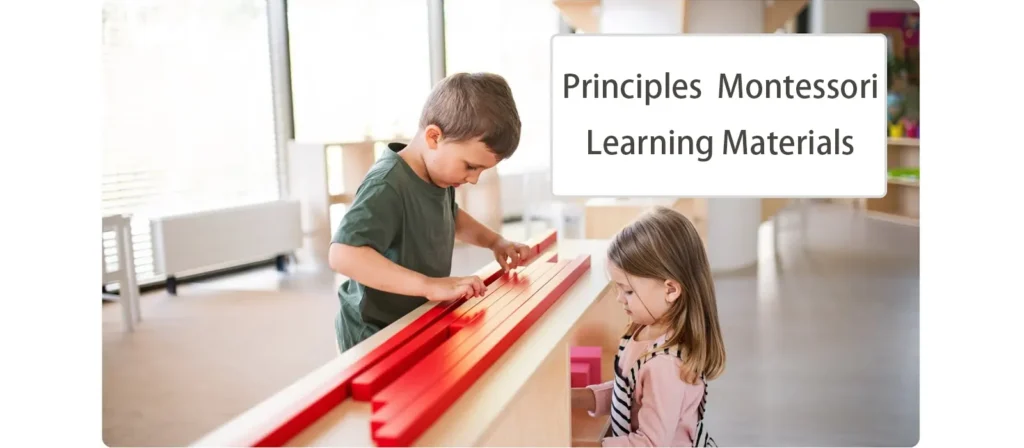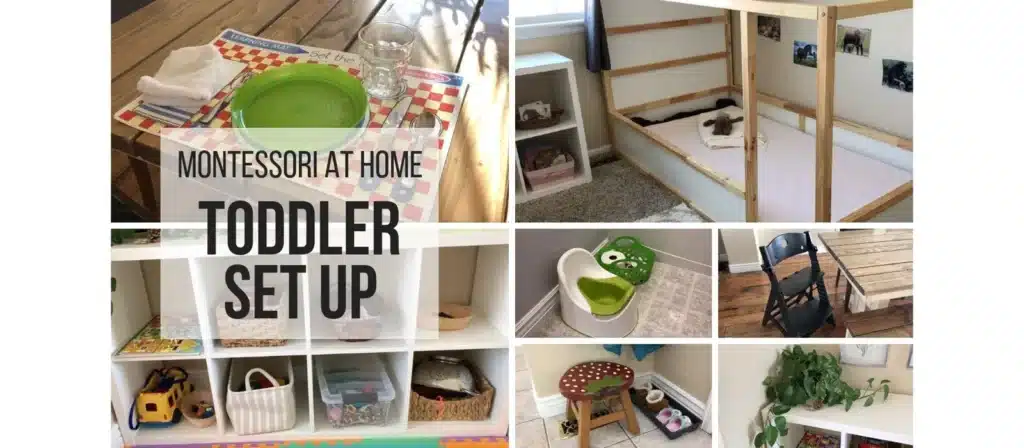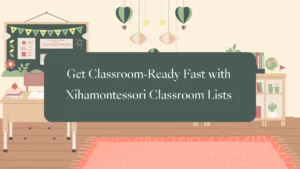Parents and educators often struggle to utilize Montessori learning materials effectively. The right approach can make a significant difference in a child’s development, but the challenge lies in knowing where to start and how to guide the process.
Montessori learning materials are visually appealing and intellectually challenging. From the iconic pink tower to practical, everyday materials such as pouring activities and button frames, these materials provide children with opportunities to develop fine motor skills, sensory perception, and problem-solving skills. Providing a prepared environment using Montessori learning materials allows your child to discover and learn independently at their own pace.
Montessori materials are specifically designed to foster independent learning and exploration. Their success lies in how they are presented and used, which demands a clear understanding of the materials and the child’s needs.
Montessori Learning Materials
Montessori Learning Materials are specially designed educational tools for use in Montessori classrooms to promote learning through hands-on experiences, exploration, and self-directed activities. These materials are at the heart of the Montessori educational method developed by Dr. Maria Montessori to engage children in learning through their natural curiosity and desire to explore.

Key Features of Montessori Learning Materials
Montessori learning materials are characterized by several distinctive features that align with the Montessori philosophy of education, which emphasizes hands-on learning, independence, and respect for a child’s natural psychological development. Here are the key features of Montessori learning materials:
- Multi-Sensory Learning: These materials engage multiple senses and are often tactile, allowing children to learn through touch, sight, and sometimes sound. This sensory engagement is crucial for developing fine motor skills and understanding abstract concepts.
- Self-Correcting: Many materials are designed so that the child can immediately see and correct their mistakes without teacher intervention. This feature encourages independent learning and builds confidence as children learn to solve problems independently.
- Aesthetic and Simple Design: Montessori materials are typically made from high-quality, natural materials such as wood and are aesthetically pleasing. They are designed to be simple and functional without unnecessary details that could distract from the learning experience.
- Realism and Nature-Based: The materials often represent real-life objects and are grounded in reality, which helps children make connections between their learning and the world around them. This realism extends to natural colors and finishes.
- Isolation of Difficulty: Each material typically focuses on one skill or concept at a time, which helps isolate the difficulty in understanding the concept. For example, color tablets teach colors separately from shapes or sizes.
- Hands-On Manipulation: Children learn by doing, meaning all materials require hand manipulation. This approach makes learning more interactive and helps solidify abstract concepts through physical activity.
- Sequential Order: Materials often follow a natural progression, moving from simple to complex and concrete to abstract. This helps scaffold learning and ensures that foundational concepts are understood before moving on to more advanced ideas.
- Scaled for Children: Everything from the size of the furniture to the dimensions of the learning materials is scaled to fit young children. This adaptability makes it easier for them to handle materials and fosters independence.
Principles Behind Montessori Learning Materials

Self-Directed Learning
Montessori learning materials promote self-directed learning. Children choose their activities and work at their own pace. This approach fosters independence and intrinsic motivation. The materials have a built-in ‘control of error’ feature. Children can self-assess and correct their mistakes without adult intervention.
Hands-On Learning
Hands-on learning is a core principle of Montessori education. Children interact with materials to understand abstract concepts. This method engages multiple senses and enhances memory retention. Accurate materials stimulate imagination and natural curiosity. Children gain a deeper understanding of math, science, and geography.
Mixed-Age Classrooms
Mixed-age classrooms are another key principle. Children of different ages learn together. Older children mentor younger ones, reinforcing their knowledge. Younger children benefit from observing and interacting with older peers. This setup creates a collaborative learning environment.

What Are the Different Types of Montessori Learning Materials?
There are various categories of Montessori learning materials, each targeting different areas of development:
Sensorial Materials
Sensorial materials help children refine their senses. These materials include solid geometric forms, knobbed puzzle maps, and colored beads. Children use these tools to explore dimensions, colors, shapes, and textures. The materials engage the five senses and develop cognitive skills.
Practical Life Materials
Practical life materials teach children everyday skills. These materials include pouring jugs, dressing frames, and polishing cloths. Children learn fine motor control and independence through practical activities. These tasks build concentration and coordination.
Language Materials
Language materials support literacy development. These materials include sandpaper letters, movable alphabets, and language cards. Children trace letters with their fingers to learn letter shapes. They use movable alphabets to form words and sentences. These activities enhance reading and writing skills.
Math Materials
Math materials introduce mathematical concepts. These materials include bead chains, number rods, and arithmetic boards. Children learn quantity, order, and operations through hands-on activities. Bead chains help with counting and addition. Number rods teach the base-ten number system. Arithmetic boards facilitate understanding of complex algebra.
Cultural Materials
These materials expose children to geography, science, art, and culture, helping them understand their world and its diversity.


How Are Montessori Materials Introduced?
Introducing Montessori materials should be done with patience and care. Start by selecting materials matching your child’s interests and developmental stage. Demonstrate how to use the material without giving away the answers. Allow your child to explore and discover independently. Remember, the goal is not to rush through the materials but to encourage deep engagement and understanding.
Here’s a step-by-step guide:
- Preparation: Before introducing a material, ensure you are familiar with its purpose and how to use it. This allows you to present it to the child confidently.
- Introduction: Invite the child to work with you. Sit at their level, maintain eye contact, and speak calmly and gently.
- Demonstration: Slowly and methodically demonstrate how the material is used. Focus on showing, not telling. For example, if using pouring materials, show how to pour without spilling, highlighting the care and precision involved.
- Engagement: Once you’ve demonstrated, invite the child to try. Offer encouragement, but refrain from correcting them immediately. Allow them to explore and learn through trial and error.
- Observation: After the initial presentation, step back and observe. Montessori educators emphasize the importance of observing children to understand their learning process and provide appropriate guidance.

Assessing Your Child’s Progress With Montessori Materials
Assessment in Montessori education is less about testing and more about observation. Watch how your child interacts with the materials. Are they engaged? Are they making discoveries? Are they able to self-correct mistakes? These observations will give you valuable insights into your child’s learning process. Additionally, you can keep track of the materials your child has mastered and gradually introduce new ones to keep them challenged.
What Mistakes to Avoid When Using Montessori Materials?
Even with the best intentions, mistakes can happen. Here are some common pitfalls to avoid:
- Overloading the Child: Introducing too many materials at once can overwhelm a child. Please stick to one new material at a time, ensuring they fully grasp it before moving on.
- Incorrect Presentation: If a material is presented too quickly or without clarity, the child might not understand its purpose. Always ensure your demonstrations are slow and deliberate.
- Interrupting Concentration: Avoid interrupting a child when they are deeply engaged with a material. Montessori education emphasizes the importance of concentration and uninterrupted work periods.
- Forcing a Child to Use a Material: If a child isn’t interested in a material, don’t force them. Respect their choices and trust in their natural learning process.
How Do Montessori Materials Differ From Traditional Learning Tools?
The fundamental difference between Montessori and traditional learning tools lies in their design and intended use. Montessori materials are purposefully designed to be self-correcting, meaning the child can see and fix their mistakes independently. This promotes critical thinking and problem-solving skills.
Traditional learning tools often focus on direct instruction, where the teacher guides the process, and the child follows. In contrast, Montessori materials encourage exploration, allowing children to discover concepts independently, leading to deeper and more meaningful learning experiences.
Using Montessori Learning Materials at Home

Setting Up a Home Learning Environment
Setting up a home learning environment requires thoughtful planning. Parents should choose a quiet and well-lit area. Low shelves can display Montessori learning materials within easy reach. Natural materials like wood and cotton create a sensory-rich space. A clutter-free environment helps children focus on tasks. Soft rugs and cushions provide comfort during activities.
Integrating Montessori Principles into Daily Activities
Integrating Montessori principles into daily activities fosters independence. Children can help with household chores using child-sized tools. Pouring water, folding laundry, and setting the table develop fine motor skills. Cooking together teaches measurement and following instructions. Nature walks encourage observation and curiosity about the world. Reading time with Montessori language materials enhances literacy skills.
Conclusion
Effective use of Montessori learning materials requires understanding, patience, and a commitment to Montessori principles. Montessori learning materials offer a unique and effective approach to education. These tools promote self-directed learning, hands-on experiences, and mixed-age interactions. These materials help children develop academic skills, social skills, and executive functioning.
Implementing Montessori materials can transform classrooms and homes. Parents and educators observe increased children’s independence, focus, and curiosity.













